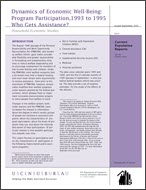Dynamics of Economic Well-Being: Program Participation, 1993 to 1995; Who Gets Assistance?
Dynamics of Economic Well-Being: Program Participation, 1993 to 1995; Who Gets Assistance?
Introduction
The August 1996 passage of the Personal Responsibility and Work Opportunity Reconciliation Act (PRWORA), also known as welfare reform, gave states considerable flexibility and greater responsibility in fomulating and implementing initiatives to reduce welfare dependency and to encourage employment for members of low-income families with children. Under the PRWORA, most welfare recipients face a 60-month time limit in federal funding and must meet certain work requirements to recieve assistance. Even prior to the enactment of PRWORA, however, several states modified their welfare programs under waviers granted by the federal goverment, which allowed them to implement innovative demonstration projects to move people from welfare to work.
Changes in the welfare system, both under waivers and the PRWORA, have increased the interest in information about the degree to which certain groups of people are involved in assistance programs, about the characteristics of program participants, about the kinds of programs they use, and about the intensity and extent of their participation. Of particular interest is how people’s participation extends over time.
This report focuses on participation and on the characteristics of participants in the following means-tested public-assistance programs:1
- Aid to Families with DependentChildren (AFDC)
- General assistance (GA)
- Food stamps
- Supplemental Security Income (SSI)
- Medicaid
- Housing assistance
The data cover calendar years 1993 and 1994, and the first 9 calendar months of 1995 (January to September),2 a time just before federal welfare reform was enacted. The data provide a set of baseline estimates for the study of the effects of the reforms.3
_______________
1 Means-tested programs are those that requireincome and/or assets of the individual or family to bebelow specified thresholds in order to qualify for benefits. These programs provide cash and noncash assistance to eligible individuals and families.
2 This report is an update of Randy Sherrod (1999), "Dynamics of Economic Well-Being: Program Participation, Who Gets Assistance? 1993 to 1994" Current Population Reports, P70-69, Washington, DC: U.S. Census Bureau.
3 Data from the 1996 and later panels of SIPP will be used to study program participation in the post-reform era. Part of the PRWORA law directed the Census Bureau to field a new survey, whose purpose is to collect the data necessary to evaluate the impact of the change. To carry out that directive, the Census Bureau began conducting the Survey of Program Dynamics (SPD). The SPD will simultaneously describe the full range of state welfare programs along with social, economic, demographic, and family changes that will help or limit the effectiveness of the reforms. The Census Bureau is collecting data for households previously interviewed in the Survey of Income and Program Participation (SIPP) from 1992-94 or 1993-95 for each of the 6 years from 1996 through 2001. Cross-sectional data from SPD were released after the 1997, 1998, and 1999 surveys. The first longitudinal file from SPD was released in the summer of 2001. For more information about SPD, see the SPD Web site, at www.sipp.census.gov/spd/
Others in Series
Publication
Publication
Publication






